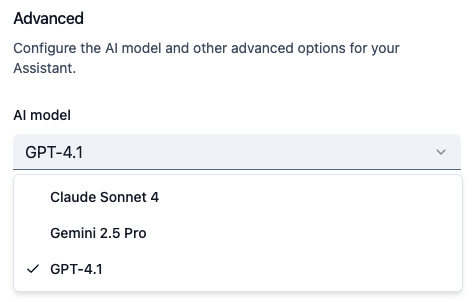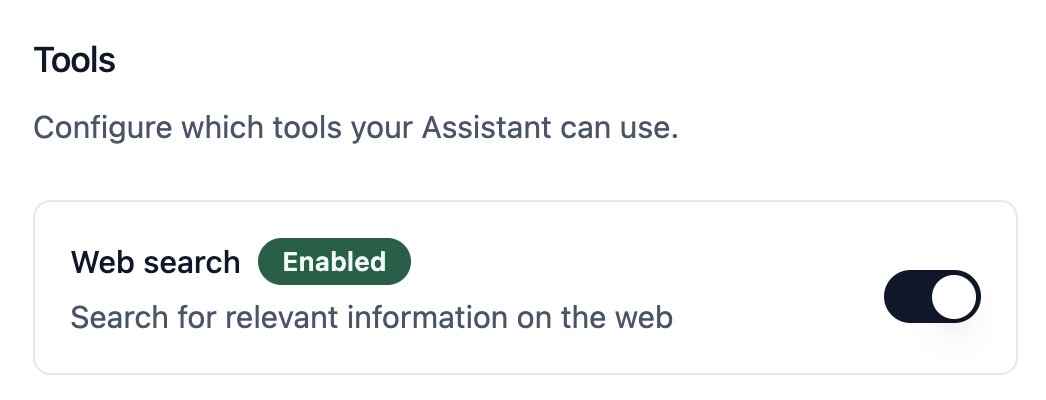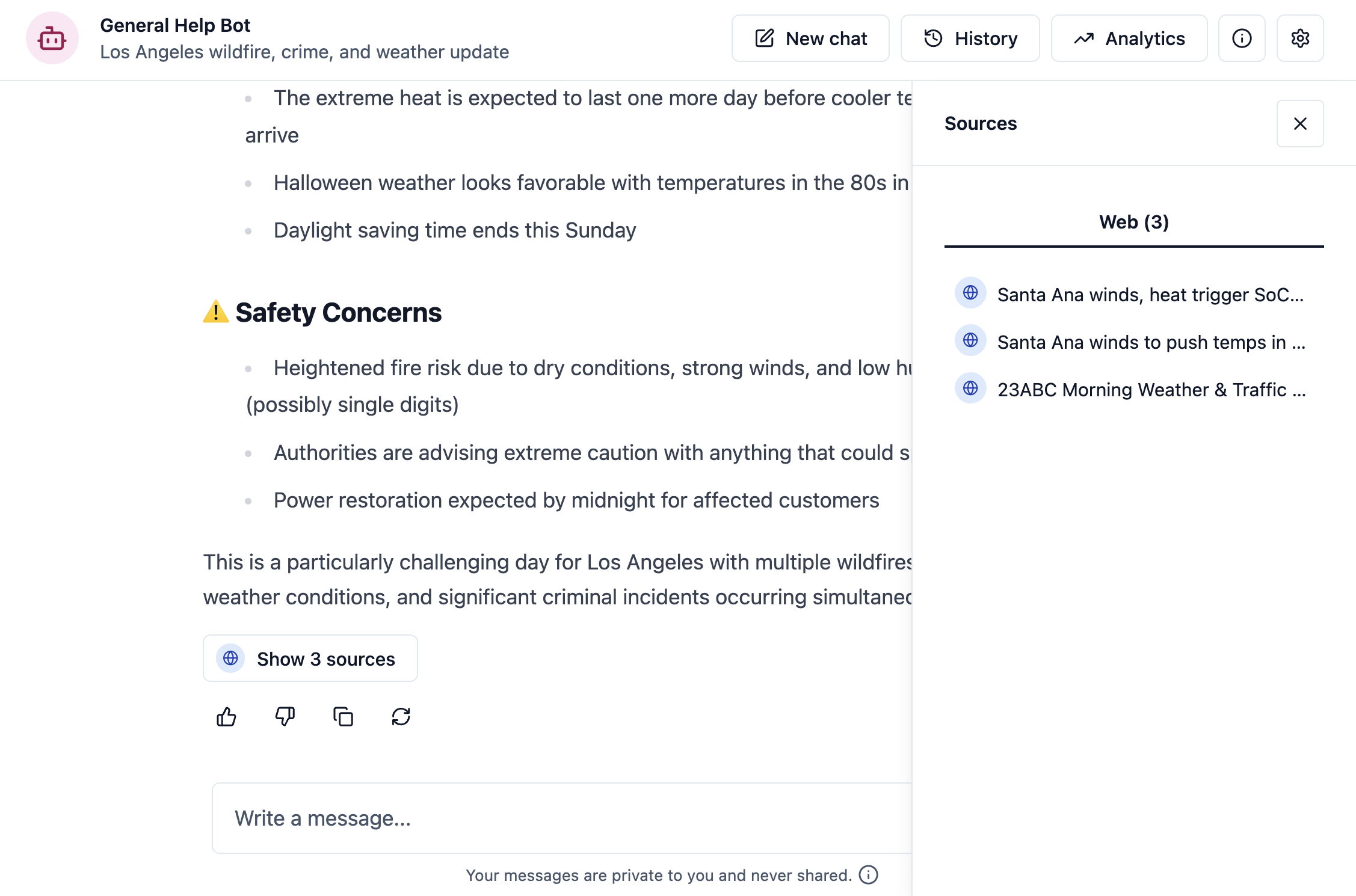
Configuring AI Models
Nectir AI allows you to select different AI models for your Assistants, each with unique capabilities and performance characteristics.Selecting an AI Model
- Navigate to your Assistant’s settings
- Click on Advanced in the settings sidebar
- Choose from the available models based on your Group needs:
- GPT-4.1: OpenAI’s latest model with enhanced reasoning capabilities and improved instruction following. Excels in generating accurate, context-rich responses for healthcare, STEM, and social sciences.
- Claude Sonnet 4: Anthropic’s advanced model with exceptional reasoning and instruction following. Shines in humanities, literature, and creative writing with its creativity and conversational flow.
- Gemini 2.5 Pro: Google’s most advanced model with exceptional multimodal capabilities and reasoning. Excels in complex problem-solving, code generation, and handling diverse content types including images, audio, and video.
Comparing Model Capabilities
| Feature | GPT-4.1 | Claude Sonnet 4 | Gemini 2.5 Pro |
|---|---|---|---|
| Reasoning | Strong complex problem-solving | Outstanding analytical and critical thinking | Exceptional complex reasoning and analysis |
| Response Style | Direct, concise, and precise | Conversational, elaborative, and nuanced | Comprehensive, detailed, and analytical |
| Best For | Healthcare, STEM, Social Sciences | Humanities, Literature, Creative Writing | Technical subjects, coding, multimodal content |
| Strengths | Accuracy, precision, problem-solving | Creativity, reasoning, ethical considerations | Multimodal capabilities, code generation, reasoning |
AI Model Temperature
Temperature is a crucial setting that controls how creative or focused your AI Assistant’s responses are. Think of it as a dial that adjusts the balance between consistency and creativity in your Assistant’s answers.
How Temperature Works
Temperature controls how creative or focused your AI Assistant’s responses are. Rather than dealing with specific numbers, think of temperature as three distinct modes:- Predictable: Consistent, reliable responses ideal for factual learning
- Balanced: Mix of consistency and creativity for general education
- Creative: Varied, exploratory responses perfect for open-ended learning
Choosing Temperature
Predictable Mode: for Factual and Analytical Learning
Predictable Mode: for Factual and Analytical Learning
Best for:
- STEM subjects requiring precise calculations
- Medical and healthcare education
- Legal studies and case analysis
- Technical documentation and procedures
- Factual recall and memorization
- Provides consistent, reliable answers
- Reduces potential for incorrect information
- Ensures students get the same accurate response each time
- Ideal for subjects where precision matters most
- “Calculate the derivative of this function”
- “Explain the steps in mitosis”
- “What are the symptoms of diabetes?”
- “List the elements in the periodic table”
Balanced Mode: for General Educational Experiences
Balanced Mode: for General Educational Experiences
Best for:
- General education across multiple subjects
- Social sciences and history
- Business and economics
- Science with conceptual explanations
- Mixed content courses
- Balances accuracy with engaging explanations
- Provides varied examples and analogies
- Maintains consistency while allowing for creative teaching approaches
- Good default for most educational applications
- “Explain the causes of World War I”
- “How does supply and demand work?”
- “What is photosynthesis and why is it important?”
- “Compare different economic systems”
Creative Mode: for Exploratory and Creative Learning
Creative Mode: for Exploratory and Creative Learning
Best for:
- Creative writing and literature
- Art and design courses
- Philosophy and ethics
- Brainstorming and ideation sessions
- Open-ended research projects
- Encourages diverse perspectives and interpretations
- Generates varied examples and creative approaches
- Stimulates critical thinking through different viewpoints
- Helps students explore multiple possibilities
- “Help me brainstorm themes for my short story”
- “What are different interpretations of this poem?”
- “Generate creative solutions to this design challenge”
- “Explore various philosophical perspectives on ethics”
Temperature Recommendations by Subject
| Subject Area | Recommended Mode | Reasoning |
|---|---|---|
| Mathematics | Predictable | Requires precision and consistency in calculations |
| Sciences (STEM) | Predictable to Balanced | Balance of accuracy for facts with some explanatory flexibility |
| Medicine/Healthcare | Predictable | Critical information requires high accuracy |
| History | Balanced | Benefits from varied perspectives while maintaining factual accuracy |
| Literature | Balanced to Creative | Encourages diverse interpretations and creative analysis |
| Philosophy | Balanced to Creative | Supports exploration of different viewpoints and arguments |
| Creative Writing | Creative | Maximizes creative potential and diverse approaches |
| Business | Balanced | Balances analytical precision with strategic creativity |
| Language Learning | Balanced | Provides varied examples while maintaining grammatical accuracy |
Setting Temperature
- Navigate to your Assistant’s Advanced settings
- Locate the Temperature setting
- Choose the mode that best fits your course requirements:
- Predictable for subjects requiring accuracy and consistency
- Balanced for general education with moderate variety
- Creative for subjects encouraging exploration and creativity
- Test with sample questions to assess the response style
- Adjust as needed based on student feedback and learning outcomes
Building AI Literacy
Introducing different AI models helps build AI literacy skills. By engaging with large language models such as GPT-4.1, Claude Sonnet 4, and Gemini 2.5 Pro, students learn how diverse models yield different results, preparing them for an AI-driven workforce. You may want to encourage students to:- Compare model outputs for the same question
- Analyze different response styles and approaches
- Understand which model performs better for specific types of tasks
Web Search
Web search allows your Assistant to search the internet in real-time to answer questions that require current information, recent events, or data beyond the Assistant’s knowledge base.What’s Web Search
| Web Search Enables ✓ | Web Search Isn’t ✗ |
|---|---|
| Real-time internet searches during conversations | URL training or web scraping to add to your Assistant’s knowledge base |
| Access to current information and recent events | A replacement for uploading course materials |
| Answers about topics not covered in your uploaded documents | Controlled by knowledge scope settings - it’s a separate, independent tool |
| Up-to-date statistics, news, and data | Permanent knowledge that persists across conversations |
Important: Web search operates independently of your knowledge scope settings. Even if your Assistant is set to “Document Only,” enabling web search allows it to search the internet when needed. The knowledge scope only controls what the Assistant uses its base knowledge (Uploaded Documents and AI Models), not whether it can perform web searches.
When to Use Web Search
Enable web search for Assistants that need to:- Answer questions about current events or recent developments
- Provide up-to-date statistics, prices, or data
- Research topics not covered in your course materials
- Verify or supplement information with external sources
- Help students explore topics beyond your uploaded content
History Course Example
“How do recent archaeological discoveries about Roman engineering relate to what we learned about their social structure in Chapter 3?”
Economics Course Example
“Compare today’s unemployment data with the economic theories we studied. Which model best explains current trends?”
Science Course Example
“Analyze recent CRISPR breakthroughs using the ethical framework from our readings. What new considerations arise?”
Business Course Example
“How do current market conditions for tech companies align with Porter’s Five Forces model we discussed?”
When NOT to Use Web Search
Consider disabling web search if:- Your course should focus on uploaded materials
- You want to prevent students from relying on external sources
- Your subject matter doesn’t require current information
- You’re concerned about external information conflicting with course content
Student Examples
When you enable web search, students interact with the Assistant normally. The Assistant automatically determines when a web search would be helpful and performs it in the background.- Synthesis & Analysis
- Real-Time Context
- Theory to Practice
Student Question: “How does this week’s Supreme Court decision on environmental law relate to the regulatory frameworks we studied in Chapter 5?”
| With Web Search ✓ | Without Web Search ✗ |
|---|---|
| “Based on today’s Supreme Court ruling, here’s how it connects to the Clean Air Act framework we studied: The Court’s decision fundamentally changes the ‘major questions doctrine’ we discussed, specifically affecting the EPA’s authority under Section 111(d) that you analyzed in your readings. Let me break down three key implications for the regulatory approaches in your textbook…" | "I can discuss the regulatory frameworks from Chapter 5, but I don’t have access to recent court decisions. I recommend searching for the latest Supreme Court rulings on environmental law to see how they might relate to what we’ve studied.” |
Enabling Web Search

First time enabling? Make sure you’ve enabled early access features in your account settings first. If early access features are not enabled, the web search toggle will not appear in your Assistant’s settings.
1
Navigate to Advanced Settings
Go to your Assistant’s settings and click on Advanced
2
Enable Web Search
In the Tools section, toggle on Web Search
Your Assistant can now perform web searches when answering questions
Web Search Sources
When your Assistant uses web search, it always shows the sources it referenced, regardless of whether you have the sources feature enabled for uploaded knowledge files.
Sources are automatic for web search: Unlike uploaded knowledge files where you can toggle sources on or off, web search results always include the links the AI referenced. This helps students verify the information and understand where the data comes from.
Best Practices
Combine with uploaded materials
Combine with uploaded materials
Web search works best when combined with your course materials. Your Assistant will reference uploaded documents first, then use web search to supplement with current information when needed.
Control which websites are used
Control which websites are used
A great way to focus web search on specific sources is to specify trusted domains directly in your Assistant’s prompt. You can instruct the Assistant to only reference certain websites or prioritize specific domains.Example prompt instructions:
- “When searching the web, only reference information from .edu and .gov domains”
- “Prioritize scholarly sources like Google Scholar and academic journals when searching”
- “Only use the following trusted news sources when searching: [list specific domains]”
- “When searching for medical information, rely only on CDC, WHO, and peer-reviewed medical journals”
Set clear expectations
Set clear expectations
Tell students that the Assistant can access current information online. This helps them understand the Assistant’s capabilities and encourages them to ask questions about recent events or data.
Monitor usage
Monitor usage
Check your Assistant analytics to see how often web search is being used. This can help you understand what types of information students are seeking beyond your course materials.
Consider subject matter
Consider subject matter
Enable web search for subjects that benefit from current information (sciences, business, current events) but consider disabling it for subjects focused solely on historical texts or specific course materials.
Next Steps
Conversation Starters
Create predefined prompts to help users begin interacting
Assistant Analytics
Monitor usage and performance metrics
Video Tutorial
See Advanced Configuration in Action
Watch how to select AI models and configure temperature settings